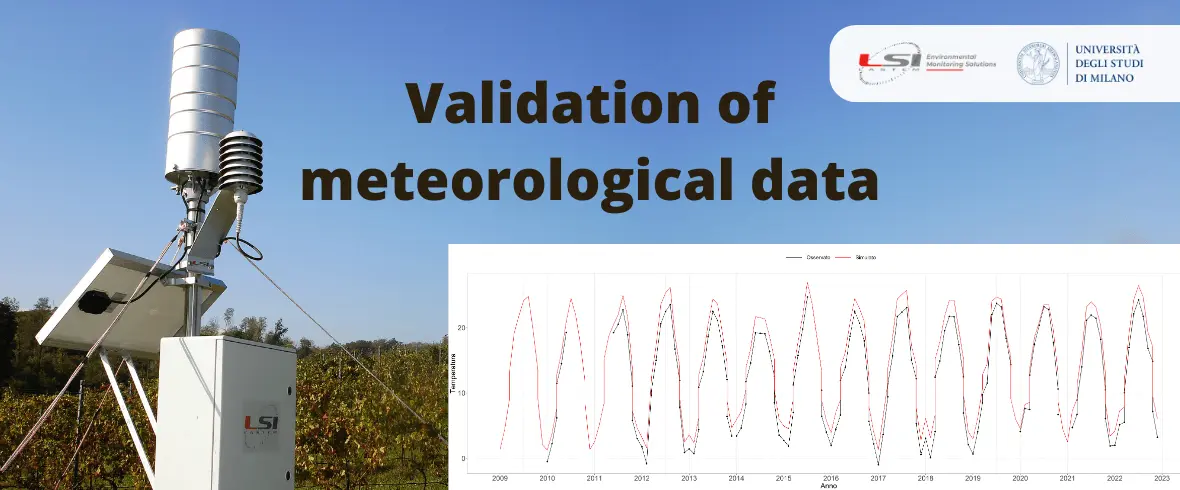Validation of meteorological data: collaboration between LSI LASTEM and the Università Statale of Milan

Introduction to the project
An interesting collaboration project between the Università Statale of Milan and LSI LASTEM has led to the creation of a methodology for the validation of meteorological data in near real time. Veronica Manara, researcher at the Department of Environmental Sciences and Policies, is carrying out a period of collaboration with the company as required by her contract financed with valuable resources on the National Operational Program (PON) “Research and Innovation 2014-2020”. Here she was able to apply his research, which aims to find a method for validating meteorological variable data, in a practical context. The results obtained so far are promising and interesting.
The research project focuses on the creation of a methodology that allows an almost real-time control of meteorological data measured from ground stations. The research started with a preliminary investigation of the methodologies currently used by the Institutions for the validation of meteorological data. Subsequently, Dr. Manara proposed an innovative method, based on the analysis of long-term data from different meteorological stations. Through the analysis of decades of data and meteorological variables, it was possible to evaluate the validity of the information collected.
Data analysis and validation method
The proposed method for meteorological data validation is based on the analysis of data from different stations. The objective is to check the consistency of the collected data and, if necessary, correct them both in real time and afterwards. To conduct this type of analysis, it is necessary to use a large number of meteorological stations, which allow data to be compared with each other, to detect any anomalies in order to intervene in a targeted and timely manner.
Calculated values and measured values
If there are many weather stations in a specific area, you can take advantage of the consistency of the behavior of the weather variables and compare the different stations with each other. Similarly, if a station has a large number of sensors, it is possible to compare the values measured by each sensor.
However, a dense network of data and meteorological stations is not always available. Therefore, the researcher has developed an innovative approach applicable when there is only one station. This method is based on the idea of creating a series of simulated data for a specific point in space which, in this case, corresponds to the location of the meteorological station in question. The goal is to use information that is completely independent from the data measured by the station itself and then compare the two values, in order to identify any anomalies and carry out a targeted intervention in near real time. This calculated data is obtained by superimposing two different components: one that describes the spatial part and one that describes the temporal part of the meteorological variability.
For the spatial part, normal reference values are used, called climatologies, which represent the average values recorded over the course of thirty years. These values are obtained from a high-resolution grid based on data measured by meteorological stations. An average value of the data measured over a given thirty years is then calculated and interpolated, taking into account the factors that influence the meteorological variable considered, such as topography, distance from the sea and altitude.
The temporal part, on the other hand, comes from reanalysis datasets. Reanalysis provides a gridded dataset of meteorological variables for the past which, unlike observations, has the advantage of not having missing data. In other words, this figure is obtained by combining information on the state of the atmosphere, starting from observations, and the most recent forecasting models.
Then, temporal information from the reanalyses and spatial information from the climatologies are combined, interpolating the point of interest data. In this way, a series of data is obtained, which can be compared with the measured values.
The second step in this process is to define criteria and thresholds for comparing the two types of data. This makes it possible to determine whether a piece of data is reliable and correct, not reliable or completely wrong.
Importance of collaboration between universities and companies
The collaboration between the Università Statale of Milan and LSI LASTEM represents a significant example of how academic research can benefit from collaboration with companies and vice versa. For researchers, this is an extraordinary opportunity to apply research to a practical and business context, in the same way, for LSI LASTEM, the collaboration with the university is an important moment for the promotion of research, to offer concrete support and expand its know-how. Thanks to this collaboration, an innovative methodology for the validation of meteorological data was tested on real data, demonstrating the importance of the synergy between university and company, which guarantees continuous evolution and improvement of data collection and analysis methods.
